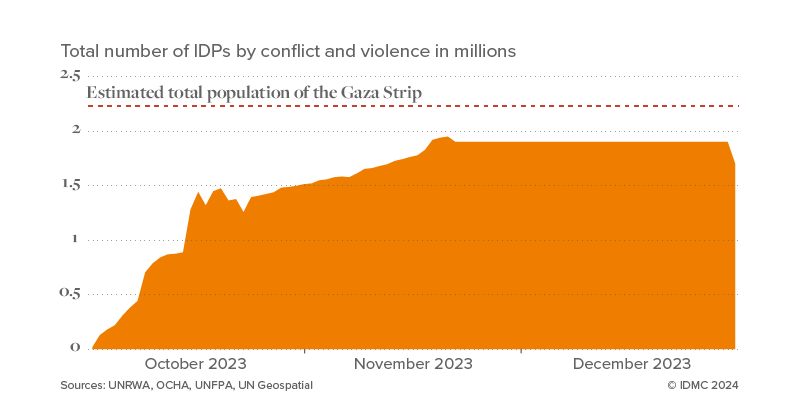
Spotlight
14 May 2024
Palestine - Conflict in Gaza leaves 83 per cent of the population internally displaced in less than three months
Hamas and other Palestinian non-state armed groups launched an attack on southern Israeli communities on 7 October 2023, prompting Israel’s security cabinet to declare a war situation the next day. The ensuing conflict has triggered the highest number of internal displacements since data became available for both Palestine and Israel in 2008 and has had wider regional implications.
Most movements took place in the Gaza Strip as a result of a military campaign launched by the Israel Defence Forces (IDF) from the air, land and sea. Evacuation calls, airstrikes and shelling triggered 3.4 million internal displacements in the last quarter of the year as people fled in search of safety and humanitarian assistance. This figure should be considered conservative, because many people were displaced within governorates before moving across them, but such movements were unaccounted for. Repeated displacement heightened IDPs’ vulnerabilities, including increased protection risks, food insecurity, and reduced access to water and sanitation. Around 1.7 million people were living in internal displacement in the Gaza Strip as of the end of the year, all of them facing acute humanitarian needs.
Displacement trends changed significantly as early as 13 October, when the IDF ordered more than a million civilians to evacuate from the northern part of the strip, which was home to around half of Gaza’s population. In the days that followed, people sought shelter in makeshift settlements, hospitals, schools and other public buildings in the southern governorates of Deir al-Balah, Khan Younis and Rafah, where they faced increased food insecurity and respiratory and waterborne diseases. The situation was further aggravated as Israel’s offensive moved south. Some areas that IDPs were told to evacuate to were bombarded, which led to an increase in civilian deaths and people’s onward displacement.
For two weeks after the start of Israel’s military campaign, the people of Gaza endured a complete siege. No food, fuel or water was allowed to enter, impeding humanitarian organisations’ efforts to deliver much needed aid. Persistent bombardments caused substantial damage to homes and infrastructure, and schools managed by the UN Relief and Works Agency for Palestine Refugees in the Near East (UNRWA) were used as shelters. Many, however, were also damaged in the conflict.
Following a series of negotiations, the Rafah border crossing with Egypt was opened on 21 October, allowing aid to enter Gaza. 3 The limited amount let in, however, was far from enough to meet IDPs’ growing needs. Access constraints were significant in many areas, particularly in the north of the strip. 4 Damage to water and sanitation infrastructure and the scarcity of fuel added to the challenge of delivering lifesaving assistance and significantly affected the operation of hospitals, which were already struggling to manage the influx of people seeking safety and care.

As days went by, overcrowding in shelters emerged as a pressing issue, with some facilities exceeding their intended capacity more than fourfold. Internally displaced children, elderly people and pregnant and lactating women faced significant mental and physical health impacts as a result of their displacement and the harsh living conditions in shelters. Many people were residing outside the shelters, where they faced additional hardships from seasonal rains, flooding and the onset of winter.
On 24 November, a week-long humanitarian pause agreed by the parties to the conflict came into effect, providing a window for increased humanitarian aid to enter Gaza and slowing the pace of displacement. The IDF, however, restricted movement to and within the north of the strip.
On the same day that the humanitarian pause ended, the IDF instructed residents around the city of Khan Younis to leave as its troops advanced into southern Gaza. With hostilities intensifying in the Khan Younis governorate, aid delivery faced obstructions again, exacerbating the needs of civilians and forcing many to flee for the second or third time.
By 7 December, 93 per cent of the population of Gaza were facing acute levels of food insecurity as per the Integrated Food Security Phase Classification (IPC). Of them, 42 per cent were estimated to face emergency levels, and 17 per cent faced catastrophic levels. To put the situation in perspective, conflict and displacement in Gaza left the largest proportion of a population facing acute food insecurity globally since IPC measurements started in 2004.
The situation among children, who make up nearly half of Gaza’s population, was particularly dire. By the end of December, all children under five were at high risk of severe malnutrition and increased risk of famine. Only 13 of Gaza’s 36 hospitals were still partially functional as of 27 December, and the lack of food and other basic survival items and poor hygiene conditions further increased the risk of physical and mental health issues for IDPs.
About 83 per cent of people in the Gaza Strip were living in internal displacement as of 31 December. Around half of the population was sheltering in the southernmost governorate of Rafah, where they faced acute humanitarian needs as the conflict continued into the new year. More than 60 per cent of the strip’s housing stock was damaged or destroyed, so even once the conflict recedes, durable solutions are likely to remain a distant prospect for many IDPs.
For references and additional information, please see the full report.
